Splitter and air dam

Front splitters are essential aerodynamic components that serve to balance the front vs. rear distribution of downforce. Splitter is typically found on the front-end of a race car, appearing as a flat extension to the very bottom of the front bumper. This splitter extends straight out, parallel to the ground, and can be made of carbon fiber or other stiff material.
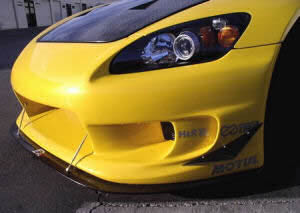 |
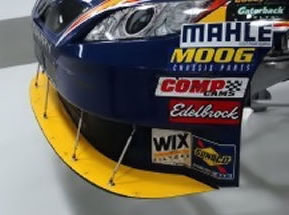 |
||
NASCAR type splitter |
|||
It is attached to the bottom of the front bumper, and may also be supported by two or more support rods at some distance forward of the bumper mounting points. These support rods ensure that the splitter stays parallel to the ground, even when there are outside forces around the splitter.
Front end splitters on a race car produce aerodynamic downforce by creating difference in the air pressure on upper and lower side of the splitter when the car moves.
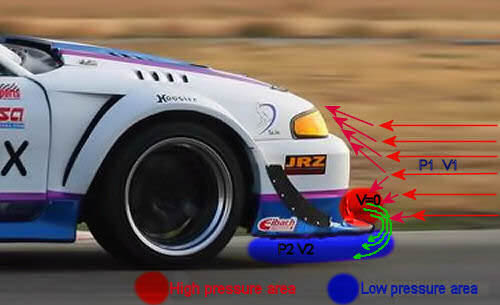
To understand how a splitter creates downforce you have to know a little bit of fluid dynamics. One should at least be aware of the difference between static pressure and dynamic pressure. It is also instructive to know how dynamic pressure is related to flow velocity. This relationship is given by the well known Bernoulli equation. Though Bernoulli's principle is a major source of lift or downforce in an aircraft or racing car wing, Coanda effect plays an even larger role in producing lift.
When a car travels at high speeds, the air pressure in front of the car can become very high. The incoming air approaches the car at V1, which is the speed of air around the vehicle, and a pressure P1 which is related to V1 according to Bernoulli's equation. P1 will be somewhat less than atmospheric. The essential point to be taken from Bernoulli's equation is that the pressure inside an air stream is related to the velocity at which the air stream is moving.
All this air ends up going both above the car (over the hood), and below the car (under the front bumper). When too much of this air gets under the front bumper, the under-car air pressure builds up. This increased air pressure contributes to lift, which causes the front-end of the car to lighten up, reducing the amount of traction at the front of the car. This high pressure (and lower speed) air, when compared to the air speed above the car, will create situation where there is increased lift over the entire car. Typically, most production street cars, when traveling at higher speeds (100km/h+) produce large amounts of positive lift.
What we want to have is lower pressure, faster-moving air below the car, and higher pressure, slower moving air above the car. The lower pressure side, when it happens to be under the car, contributes to reduced lift. When the lift is reduced sufficiently to the point where there is negative lift, there is net positive downforce.
As the air stream velocity goes up, the dynamic pressure within the air goes down. In simple terms - The air travels faster in the low pressure area created under the splitter, and that "sucks" the car's nose down, creating downforce and reducing understeer, especially on a track where you have fast flowing corners.
The splitter itself does not actually create downforce. What the splitter does is that it increases the area over which high pressure can build up. The more high pressure there is above the splitter, the more low pressure is below the splitter, greater the net downforce there is. Additionally, if there are openings in the front bumper (above the splitter or lip) for brake ducts or radiator cooling, this increased air pressure will encourage more air to flow into these openings.
The drawing above shows what happens when incoming air reaches the front of the vehicle. The air must come to a stop before it turns to move either up and over, down and under, or around the vehicle. The area where the oncoming air flow comes to a stop is termed the "stagnation point", since the velocity has gone down and the pressure has gone up (the "stagnation" pressure). In other words, the front of the moving vehicle is an area of relatively high pressure.
The lower the car is to the ground the greater suction that will be created by the ground effects, therefore the splitter is usually located at the lowest possible point.
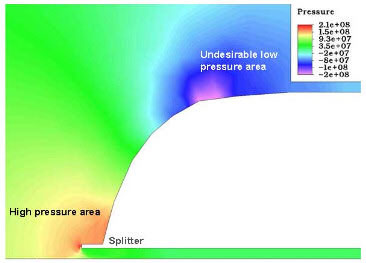
However if the splitter is too close to the ground it will stall, producing less downforce and more drag (exactly the opposite of what's desired). This is because air will not be able to go trough the bottom part of the splitter, so the speed of the flow there (on the bottom part) will decrease, increasing the pressure. From this we can see that a splitter can be very sensitive to ride height. In order to remove this sensitivity we use different heights on the splitter, in other words, an anhedral shape. This solution has the advantage that in the case that the car touches the ground, part of the splitter will continue to create downforce.
If you have a heavy front-engine car prone to understeer, apart from reducing weight, upgrading the suspension, widening the wheel track and adding fatter rubber up front, you can incorporated a splitter to help eliminate understeer.
 |
|
 |
The shape and design of the splitter is pretty basic - It's actually just a half-moon shaped flat sheet that fits horizontally under the car. Here on the pictures we have basic NASCAR splitter and below is aftermarket Ford Mustang splitter.
Of course, more sophisticated racing classes have more sophisticated splitters.
 |
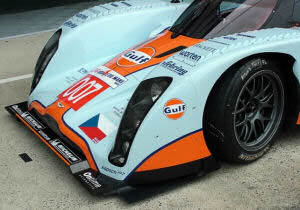 |
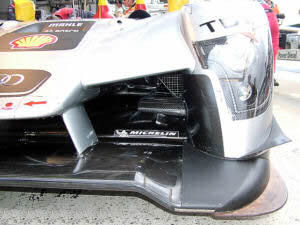 |
Here we can see front splitters of Audi R8, Aston Martin Lola Le Mans 2009 and Audi R15 Le Mans 2009. We can see that on Audi R15 Le Mans, splitters are integral part of front wings assembly. A lot of the people will say: "Hey, there is no splitter, only front wing" but that's not a case! What we can see on Audi R15, is more splitter than the wing, and all of this is part of front diffuser. |
The splitter seals off the entire area all the way from the front of the vehicle and stops just short of the front wheels. This creates a decent low-pressure area under the car to assist downforce, but only at speeds above around 120 kmh. In slower corners the car still relies on mechanical grip - trick with mudded suspension and wider rubber will do the job. The splitter adjusters must be lightweight and spring-loaded.
To construct the splitter and make it strong and flexible in case of accidental bumps etc, you can incorporated multiple layers of composites - Kevlar for flexibility, overlaid with carbon fiber for strength, but the cost will not justify the means. You have to pay stupid money for the composites. 8mm plywood or fiberglass composite works just as well and makes surprisingly lightweight splitters for a fraction of the cost.
Besides, if you have a mishap during Friday practice or on the parking in local market store sidewalk and need to replace your front splitter, you're not likely to find Kevlar and carbon fiber at the local hardware store.
This article was written with the functionality of race cars in mind, but something that's always been bugging me is the stupid aftermarket spoilers and splitters the ricer crowd put on their cars for street use, so I've decided to include this section...
First thing I want to say again is that splitter is aerodynamically effective on the speed over 120 kmh. If you are not in the racing and you are using the car for everyday commutation, how often you can use aero advantages of the splitter.
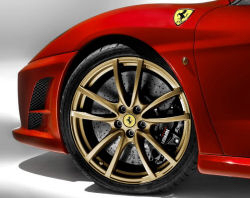 |
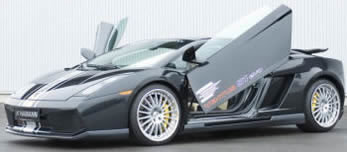 |
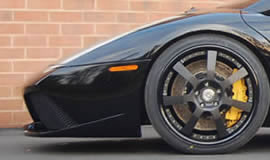 |
 |
Take a look at the ground clearance on a street legal Ferrari F430 Scuderia, Hamann-Lamborghini Gallardo or new Lotus Evora (clockwise). The designers must have given this some thought when designing the front-end and splitter on these extreme sport cars. Note how low the car is, but even with such little ground clearance the stock spoiler is relatively safe from unexpected speed bumps and curb-side parking. Splitter is not protruding in some crazy way. If Ferrari think that is OK, why shouldn't you.
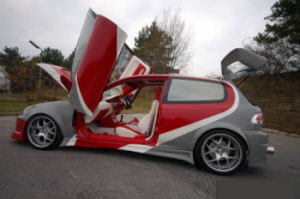
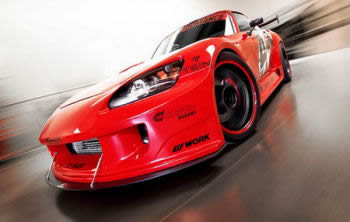
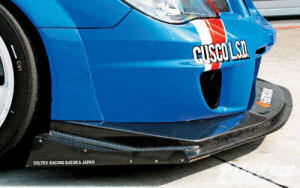
The pic on left illustrates the lack of ground clearance with a lowered ride height and a splitter mounted far ahead of the front wheels. Look closer and you'll see that the bottom of the spoiler would hit the tarmac or speed bumps and curb-side parking.
For splitter, a general guideline is to be 2x longer than the ground clearance to be effective. So if the bumper is 5 cm off the ground, the splitter needs to stick out 10 cm. They are kind of dangerous, and possibly illegal on street cars.
It gets worse - This pics only shows that this set-up is obviously not safe for street use.
You got to admit, it's a tad worrying when we see raced-out cars on our roads with more radical set-ups than race cars when it comes to front spoilers and ground clearance. Please think twice before you fit radical spoilers to the front of your car. Hit something at the wrong angle and that nice race spoiler of yours could be stuck under your front wheels and you'd be sliding along like you were on an ice rink. That could be a helluva ride, until you kill someone. I can't even think what will happen with pedestrian legs if you hit him with this.
I have to admit. They look nice, but nothing more than that.
What is an air dam:
An air dam (a.k.a. "front air dam") is usually a shaped part of the lower portion of the front bumper. It is sometimes called a "front lip" or "lip spoiler." It can be molded as part of the front bumper, or it can be a separate part that is attached at the front-lower portion of the front bumper. Unlike the splitter, the lip is not a flat "sheet" of material. Function of both are the same, to create lover and higher pressure areas, but in case of air dam, in less extreme way.
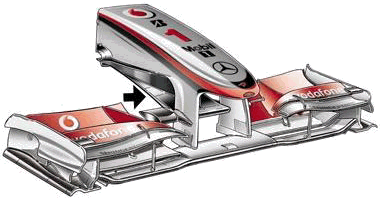
Formula 1 splitter is known by many names, such as the shadow or legality plate, T-tray or bib. -T-tray or splitter – is the flat area that the plank or skidblock is attached to and stretches out at the front underneath the raised nose area of the car.
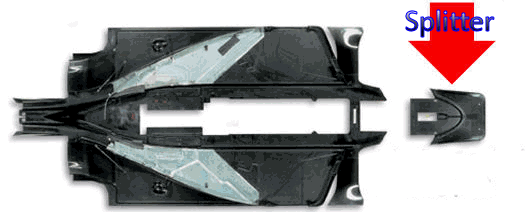
In the late eighties when designers were slimming and raising the nose of the cars, there was a need to create a floor section under the front of the monocoque to meet the flat bottom rules. The first splitter used in Formula 1 was with the Tyrrell 019 with its fully raised nose. Since then the spli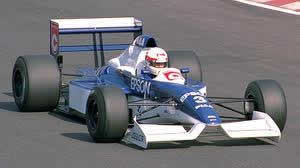 tter has been more and more exposed as teams seek to raise and narrow the chassis cross section for aerodynamic benefit.
tter has been more and more exposed as teams seek to raise and narrow the chassis cross section for aerodynamic benefit.
Formula 1 splitters regulatory role has been intended to form the flat bottom of the car and form an attachment for the plank running along the length of the flat floor. Splitter must form the flat floor at reference plane level. The splitter must also shadow the plan profile of the monocoque, such that the monocoque can not be viewed from beneath the splitter. Original intention of FIA was only that. However, as everything in Formula 1, this bodywork forming the floor has been exploited and the splitter now forms aerodynamic and chassis functions of its own. As the term suggests the splitter separates (split) the airflow passing under the raised nose to two separate airflows. One pasing above and one pasing below the floor. On the upper part of the splitter, on the point where splitter meets monocoque, there is bow shape. This “shape” also splits the airflow passing over the floor between left and right.
Air spills under and over the spliter.
Teams make use of this powerful flow to alter the air pressure distribution across and over the underfloor to further improve airflow through the diffuser. Together with fences, vortex generators and previously bargeboards, the splitter forms a critical role in the onset flow for the diffuser.
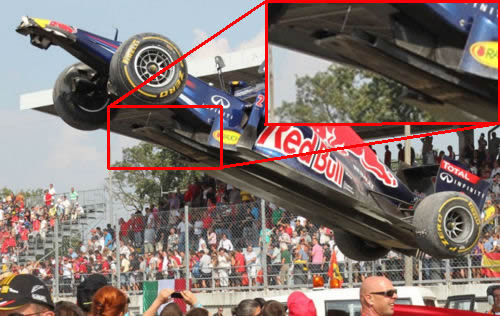 |
GP of Monza 2011 footage of the Mark Webbers Red Bull being lifted on a crane over a spectator area |
Being mounted low and far forward, the splitter also forms good location for ballast. Depending on the prevailing tire and aerodynamic issues, teams can run as much as 50% of the cars weight on the front axle. With a rear engine car, the only way to do this is to ballast the front of the car and the splitter has been known to be made entirely from metal in order to maximise front end weight bias.
Since the 2007 season-opener in Australia, there has been much talk of 'movable' floors on Formula One cars. Teams are developing a way to mount the splitter in such a way that it will pass the standard deflection test during the scrutineering, but then lift under greater aerodynamic loads at speed on the circuit, providing significant aerodynamic gains. All teams were working on that, but only Ferarri and BMW have a guts to actually run it.
If you introduce a way to allow the car's bib to lift at high speed, it will lead to stall of underbody aerodynamics. That means that the airflow passing through the diffuser no longer closely follows the diffuser's profile. Instead, at a certain point - determined by air pressure levels close to the diffuser wall - the airflow detaches and proceeds on its own horizontal trajectory. And that lead to less drag with less downforce. Read more about movable floor in my article here.
F1 rules deem that the front area of this splitter (T-tray, bib) needs to be shaped in a certain way. Article 37.1 states that the surface formed by all parts lying on the reference plane must: "Have a 50mm radius (+/-2mm) on each front corner when viewed from directly beneath the car, this being applied after the surface has been defined." The below image from the FIA rule books makes clear where the 50mm radius needs to be.

For most of the 1970s, there seems to have been two fundamental way ot thinking about front-end aerodynamic concept of Formula 1 cars.
 |
Nose cone of BRM P160, Tyrrell 006 and Mclaren M19 |
Some of the cars, such as the McLarens, Lotuses and Ferraris, continued to run with front wings, but another group appeared to abandon that concept for most of the decade, running instead a front airdam/splitter. This latter group included teams such as March, Brabham and Tyrrell, with Jackie Stewart winning the 1971 and 1973 World Championships in Tyrrell designs with just such a front-end designe.
 So what was the idea? Well, part of the motivation was presumably to reduce the lift, drag and turbulence created by the front wheels. The front spoilers were much wider than front wings, and partially shrouded the front wheels, diverting airflow over and around the wheels.
So what was the idea? Well, part of the motivation was presumably to reduce the lift, drag and turbulence created by the front wheels. The front spoilers were much wider than front wings, and partially shrouded the front wheels, diverting airflow over and around the wheels.
So that was part of the idea. The other possible motive is perhaps more interesting, because it involves ground-effect.
A airdam/splitter provides a vertical barrier which
1. maximises the high pressure stagnation point at the front of the car, and
2. accelerates the airflow through the restricted gap between the airdam/splitter and the ground surface. 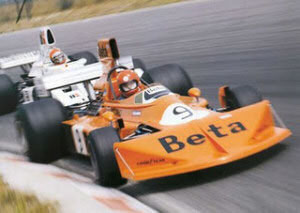
A horizontal splitter exstending from the bottom of the airdam/splitter then takes advantage of the high pressure of the stagnation point to generate some extra downforce.
A front airdam/splitter is partially, then, a ground-effect device, which perhaps explains why cars such as the Brabhams and Tyrrells were still able to win Grands Prix against those utilising conventional front-wing arrangements. The photo here shows a Tyrrell 6 wheeler running quite a degree of rake, which would serve to accentuate the ground-effect of the front spoiler.
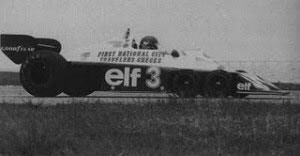 So, perhaps surprisingly, ground-effect in Formula 1 actually predates the underbody venturi tunnels and skirts used on the Lotus 78/79. And in fact, Gordon Murray began experimenting with ground-effect on the Brabham BT44 back in 1974, arriving at "an inch-deep underbody vee, something like a front airdam, but halfway down the car." (Vacuum Clean-Up, Adam Cooper, Motorsport, May 1998, pp64-69).
So, perhaps surprisingly, ground-effect in Formula 1 actually predates the underbody venturi tunnels and skirts used on the Lotus 78/79. And in fact, Gordon Murray began experimenting with ground-effect on the Brabham BT44 back in 1974, arriving at "an inch-deep underbody vee, something like a front airdam, but halfway down the car." (Vacuum Clean-Up, Adam Cooper, Motorsport, May 1998, pp64-69).
The introduction of underbody venturi and skirts presumably spelt the death sentence for front spoilers, as the emphasis then shifted to feeding the underbody with as much airflow as possible.






